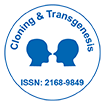
Cloning & Transgenesis
Open Access
ISSN: 2168-9849

ISSN: 2168-9849
Alyaa Rakha
Dolly the sheep cloning “the first cloning process” was derived by somatic cell nuclear transfer and it had reported that the clone got premature senescence as a result of continues telomere shortening and ongoing decrease in telomerase activity by time; thus majority of recent researches is directed to use other types of donor cells to be transferred into the recipient enucleated oocyte to maintain full-term and healthy postnatal development for the clone. Embryonic cells such as embryonic stem cell and primordial germ cell were on top as a product of high activity of telomerase, but it cannot be used to clone an adult and primordial germ cell could only be used in nuclear transfer in early stages of embryonic development. Adult stem cell and adult germ cell also had shown increase in telomerase activity but using germ cell as a donor cell at specific day postcoitum had shown incompetence to satisfy full-term development of embryo making it inadequate to be donor cell in cloning process. Another effective cell that could reverse cellular aging in cloning is fibroblast cell. Sertoli cell in male and cumulus cell in female had shown the high efficiency to be donor cells in nuclear transfer. As we suppose that cloning will soon be applicable in many fields such as pharmacy, agriculture, biotechnology and medicine, here, we review current progress in cloning including several types of donor cells had been used in cloning.